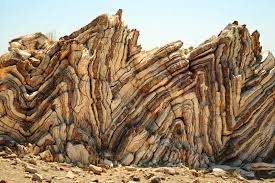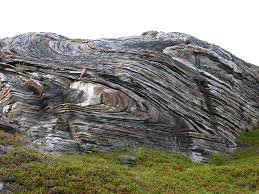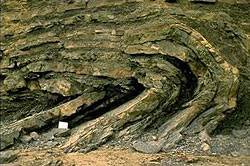What I Learnt In Class - Deformation of Rocks and The Types of Deformational Response.
Hello Steemians!!
Some days ago I started my what I learnt in class series and my first article was on photo geology and how it helps in the interpretation of geologic features on the ground. Today I will be talking about deformation of rocks, the different types of deformational response, factors that influence deformational response and the components of deformation.
To start with today's lesson let's talk about what deformation is;
What is Deformation?
Deformation is the transformation from an initial to a final geometry by means of rigid body rotation, strain(distortion) and/or volume change. In most cases, particularly in the field, the term refer to as distortion(strain) is expressed on a rock due to external forces or process. It literally means a change in form or shape. However, rock masses can be translated or rotated as rigid unit during deformation without any internal change in shape. For instance, fault block can move during deformation without any internal change in shape. We refer to them as rigid body deformation, as opposed to non-rigid body deformation (strain or distortion). Both are product of the stress acting on the geologic body. The stress acting on the plain is the force per unit area of the plain.
Stress = F/A
Types of Deformational Response
When the applied stress that results into elastic deformation is released, the body return into original position, orientation, shape or size. There are two types of deformational response namely Brittle ad Ductile Deformation.
Brittle Deformation
This occurs when a brittle rock response to applied stress by breaking.
Ductile Deformation
A rock response to ductile deformation when it bends or change shape permanently.
Factors That Influence Deformational Response
Nature of the rock : Granite are brittle because they are compacted while shale are ductile because shale are made up of combination materials.
Amount of Stress : Abrupt stress can lead to brittle deformational response, while gradual implemental stress leads to elastic or ductile deformational stress.
Time and rate of applied stress.
Temperature and pressure : An increase in temperature and pressure will enhance ductility, while when temperature and pressure is absence lead to brittle deformation.
Components of Deformation
Deformation refers to changing in shape, position or orientation of a body resulting from application of differential stress. On the other hand, differential stress is a state in which the magnitude of stress is in equal direction. Deformation consist of components
Rotation:- It is pivoting of a body around a fixed axis which is taken to mean the entire deformed rock volume.
Translation:- This is the change in position of a body. Translation moves every particle in the rock and in the same distance e .g a rigid body rock that moves down the fault plain.
Strain:- This refers to the distortion or change in shape and volume of a body. In homogenous strain, strain at one point in a body is the same as that at another point in the body. Heterogenous strain means that the strain us not equal throughout the body. Any change in shape with or without change in volume is referred to as strain and it implies that particles in a rock have change position relative to each other.
You can also check out my previous article on what I learnt in class
photo geology and how it helps in the interpretation of geologic features on the ground.
Reference
My Class Note Book



You received a 10.0% upvote since you are not yet a member of geopolis.
To read more about us and what we do, click here.
https://steemit.com/geopolis/@geopolis/geopolis-the-community-for-global-sciences-update-3
If you do not want us to upvote and comment on your posts concerning earth and earth sciences, please reply stop to this comment and we will no longer bother you with our love ❤️
Thanks @geopolis.. I haven't really had time to visit the community. I will surely engage in the community activities soonest.
No wonder some rocks end up looking really weird!
Yeah.. Most rocks are structurally deformed.
Rocks are always interesting.
Their structure,formation and composition.
This helped!